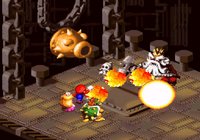Super Mario RPG
|
|
| Super Mario RPG | |
| Missing image SuperMarioRPGSNESCoverArtUS.jpg Super Mario RPG: Legend of the Seven Stars' US cover art. | |
| Developer(s) | Squaresoft |
| Publisher(s) | Nintendo |
| Release date(s) | May 13, 1996 |
| Genre | Adventure and Role-playing (RPG) |
| Mode(s) | Single player |
| Rating(s) | ESRB: Kids to Adults (K-A) |
| Platform(s) | Super Famicom/Super NES |
Super Mario RPG: Legend of the Seven Stars (スーパーマリオRPG) was the last Mario game made and released for the Super Famicom/Super Nintendo Entertainment System, and was the last Square-produced game for a Nintendo video game console until 2003, with the debut of Final Fantasy: Crystal Chronicles for the Nintendo GameCube. This was also the first role-playing game (RPG) in the Mario series. It contains token similiarities to Chrono Trigger and the Final Fantasy series with a story based on the Mario universe. Since it was an easy-to-play RPG starring Mario, it introduced many long-time Mario fans to RPGs and as such is sometimes seen as an introductory RPG.
In this game, an extraterrestrial named Smithy takes over Mario's world. In order to stop him Mario and his friends have to find seven star pieces, a form of the collect the pieces plot.
Super Mario RPG introduced a number of new characters while retaining classic Mario characters. Playable members of Mario's party include:
- Mallow, a prince of Nimbus Land who was raised by frogs,
- Geno, a doll inhabited by a spirit sent to Mario's world to fix the Star Road,
- King Bowser Koopa, Mario's long-time nemesis/rival ever since the beginning, and
- Princess Peach Toadstool, who, once rescued, becomes a fighting member of the party.
Subplots include helping Mallow find his parents, finding Princess Peach, and helping King Bowser get his keep back. This is the first game in which Mario and Bowser are allied; however, the pair have been reunited since, in games such as Mario and Luigi: Superstar Saga.
No official sequel to Super Mario RPG was ever released, however Paper Mario (Nintendo 64), Mario and Luigi: Superstar Saga (Game Boy Advance), and Paper Mario: The Thousand-Year Door (Nintendo GameCube) are considered to be its spiritual successors. In fact, Paper Mario was originally titled Super Mario RPG 2. However, because of Square's involvement in the original game, direct sequels were not legally possible after the Nintendo-Square split in the 1990s. However, some of the original team members (including some from Square) that worked on Super Mario RPG worked on Mario and Luigi: Superstar Saga as well, including director Yoshihiko Maekawa and music composer Yoko Shimomura.
Certain conventions established in the original Mario RPG have also carried over to the de facto sequels as well, such as the use of "Flower Points" instead of magic points, timed attacks that require precise button-pressing, and the general overall theme of seven magical stars which must be collected.
| Contents |
Game play
The battles featured a cross between platforming and traditional RPG battles. All enemies were seen on the world map; Mario must approach the enemy to begin combat. This allows the player to avoid unwanted battles by jumping over or walking around the foe.
The other wrinkle to the battles was the use of timed button presses and other movements (such as rotating the D-pad or pressing Y repeatedly) to increase, or in a few cases, determine, the power of the moves the characters were using. Timed button presses were also useful for guarding attacks, taking slightly less damage or no damage at all. The constant button presses in between menus kept a player engaged in the battle the whole time, or else it was a lot harder to win.
Unlike many RPGs before and after its release, much of the gameplay was outside of monster battles. As a result of Mario's ability to jump, the game played in some parts similar to a 3D platformer.
References to other games
Super Mario RPG contains many references to other games by Square and Nintendo. Culex of Monstro Town is a reference to Final Fantasy-style bosses and has Final Fantasy-esque battle music (the boss battle theme of Final Fantasy IV, the traditional pre-Final Fantasy VII victory theme, and the Final Fantasy prelude theme were all reused in this segment). Also, Link and Samus Aran made cameo appearances sleeping in various inns of the game. Also within the game are models of Captain Falcon's F-Zero racer and a Star Fox Arwing. In addition, there is an Easter egg in the Booster Tower area that allows the player to control the original Mario as he appeared in Super Mario Bros. on the Nintendo Entertainment System for a short time. A similar trick (as revealed in Nintendo Power), is also present in Paper Mario, as well as its sequel, Paper Mario: The Thousand-Year Door.
Sound
The Super Mario RPG musical score was composed by Yoko Shimomura (Front Mission), Koji Kondo (Super Mario World), and Nobuo Uematsu (Final Fantasy series). The arrangement was performed by Yoko Shimomura.
See also
External links
- Soundtrack listing and review at SoundtrackCentral (http://www.altpop.com/stc/reviews/smrpg.htm)
- RPG Classics (http://www.rpgclassics.com/shrines/snes/smrpg/)ja:スーパーマリオRPG


